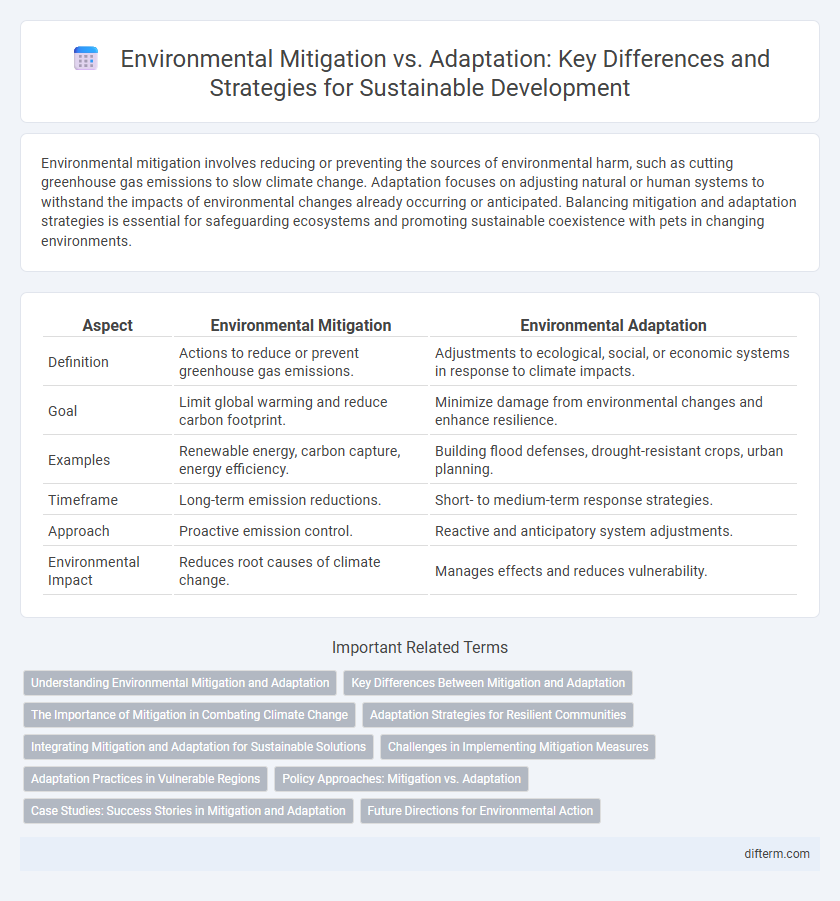Environmental mitigation involves reducing or preventing the sources of environmental harm, such as cutting greenhouse gas emissions to slow climate change. Adaptation focuses on adjusting natural or human systems to withstand the impacts of environmental changes already occurring or anticipated. Balancing mitigation and adaptation strategies is essential for safeguarding ecosystems and promoting sustainable coexistence with pets in changing environments.
Table of Comparison
| Aspect | Environmental Mitigation | Environmental Adaptation |
|---|---|---|
| Definition | Actions to reduce or prevent greenhouse gas emissions. | Adjustments to ecological, social, or economic systems in response to climate impacts. |
| Goal | Limit global warming and reduce carbon footprint. | Minimize damage from environmental changes and enhance resilience. |
| Examples | Renewable energy, carbon capture, energy efficiency. | Building flood defenses, drought-resistant crops, urban planning. |
| Timeframe | Long-term emission reductions. | Short- to medium-term response strategies. |
| Approach | Proactive emission control. | Reactive and anticipatory system adjustments. |
| Environmental Impact | Reduces root causes of climate change. | Manages effects and reduces vulnerability. |
Understanding Environmental Mitigation and Adaptation
Environmental mitigation involves reducing the sources or enhancing the sinks of greenhouse gases to minimize climate change impacts, such as implementing renewable energy or reforestation projects. Adaptation focuses on adjusting natural or human systems to cope with current or expected climate effects, like building flood defenses or developing drought-resistant crops. Understanding both strategies is crucial for developing comprehensive policies that address climate resilience and sustainability challenges effectively.
Key Differences Between Mitigation and Adaptation
Environmental mitigation focuses on reducing greenhouse gas emissions and limiting the severity of climate change by addressing root causes such as fossil fuel consumption and deforestation. Adaptation involves adjusting natural or human systems to minimize the negative impacts of climate change, including infrastructure modifications and ecosystem management. Key differences lie in mitigation's emphasis on prevention and adaptation's focus on resilience and adjustment to existing climate effects.
The Importance of Mitigation in Combating Climate Change
Environmental mitigation plays a critical role in combating climate change by directly reducing greenhouse gas emissions and slowing global warming. Implementing renewable energy technologies, improving energy efficiency, and enforcing stricter emission regulations are essential mitigation strategies that limit the severity of climate impacts. Prioritizing mitigation efforts helps preserve ecosystems, protect biodiversity, and reduce long-term economic costs associated with extreme weather events.
Adaptation Strategies for Resilient Communities
Adaptation strategies for resilient communities emphasize enhancing infrastructure, implementing early warning systems, and promoting sustainable land use to reduce vulnerability to climate impacts. Integrating nature-based solutions such as restoring wetlands and urban green spaces helps buffer extreme weather events while supporting biodiversity. Community engagement and climate education foster local capacity to respond effectively to environmental changes and strengthen social cohesion.
Integrating Mitigation and Adaptation for Sustainable Solutions
Integrating mitigation and adaptation strategies enhances resilience against climate change by reducing greenhouse gas emissions while simultaneously preparing communities for its impacts. Combining renewable energy adoption with climate-resilient infrastructure development creates sustainable solutions that address both causes and consequences of environmental change. This holistic approach leverages ecosystem-based methods to promote biodiversity conservation and carbon sequestration, ensuring long-term environmental and socio-economic benefits.
Challenges in Implementing Mitigation Measures
Implementing environmental mitigation measures faces significant challenges such as high financial costs, technological limitations, and political resistance, which hinder large-scale adoption. The complexity of reducing greenhouse gas emissions across diverse sectors requires coordinated policy frameworks and stakeholder engagement, often lacking in many regions. Furthermore, overcoming social inertia and addressing equity concerns remain critical barriers to effective and sustainable mitigation efforts.
Adaptation Practices in Vulnerable Regions
Adaptation practices in vulnerable regions prioritize building resilience by enhancing infrastructure, improving water management, and promoting sustainable agriculture to withstand climate impacts. Community-led initiatives often integrate traditional knowledge with modern technology to address local environmental challenges effectively. These adaptive strategies reduce risk exposure and support long-term socio-economic stability amidst changing climate conditions.
Policy Approaches: Mitigation vs. Adaptation
Policy approaches to environmental challenges emphasize mitigation strategies that reduce greenhouse gas emissions to limit climate change impacts, such as carbon pricing and renewable energy incentives. Adaptation policies focus on enhancing resilience by implementing infrastructure improvements, disaster risk management, and ecosystem restoration to cope with existing climate effects. Integrating mitigation and adaptation within national frameworks optimizes resource allocation and strengthens overall climate action outcomes.
Case Studies: Success Stories in Mitigation and Adaptation
Case studies in environmental mitigation highlight successful efforts such as Costa Rica's reforestation programs that significantly reduced carbon emissions and restored biodiversity. Adaptation examples include the Netherlands' advanced flood defense systems, which protect vulnerable populations from rising sea levels. These success stories emphasize the importance of integrating innovation, policy, and community engagement to address climate change effectively.
Future Directions for Environmental Action
Future environmental action requires a balanced integration of mitigation strategies that reduce greenhouse gas emissions and adaptation measures that enhance resilience to climate impacts. Advances in renewable energy technologies and carbon capture methods are critical for cutting emissions, while adaptive infrastructure investments and ecosystem restoration improve climate resilience. Policymakers must prioritize scalable, data-driven solutions that address both mitigation and adaptation to ensure sustainable development under changing environmental conditions.
environmental mitigation vs adaptation Infographic

 difterm.com
difterm.com